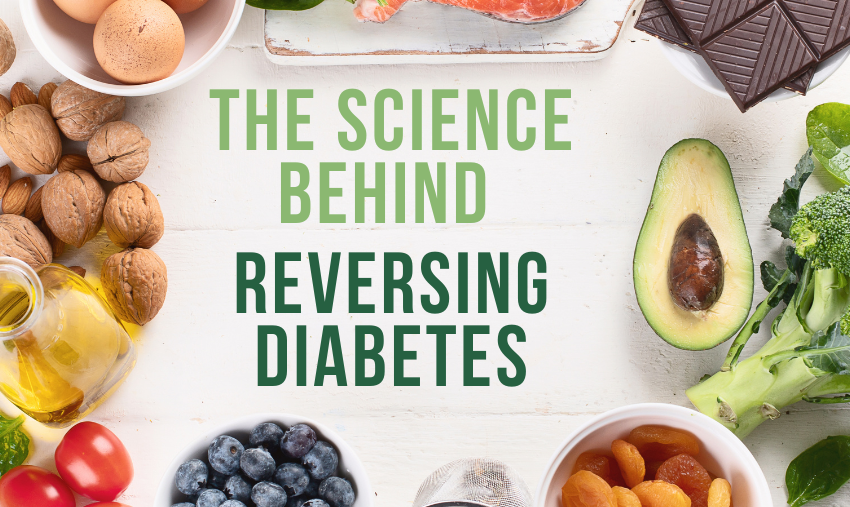Can Diabetes Be Reversed? What Science Says

Can Diabetes Be Reversed? What Science Says
Diabetes is a condition that affects millions of people worldwide. For years, many people with Type 2 diabetes were told that their diagnosis meant a lifelong struggle with blood sugar management. However, emerging research has provided hope for many: Type 2 diabetes can be reversed through lifestyle changes, particularly in the early stages.
But what about Type 1 diabetes? Can it also be reversed? What does reversal even mean in the context of diabetes? In this article, we explore the possibility of reversing diabetes, dive into scientific evidence, and provide actionable strategies for managing diabetes effectively.
Is It Possible to Reverse Diabetes?
The answer is yes, but it depends on the type of diabetes.
Type 2 Diabetes: Yes, It Can Often Be Reversed
Type 2 diabetes is the most common form of diabetes, and in many cases, it can be reversed or put into remission through lifestyle changes such as diet, exercise, and weight loss.
Reversal doesn’t mean the disease is gone forever. It’s more like remission, blood sugar levels return to normal or near-normal levels without the need for medication. However, this doesn’t mean you’re cured. Without sustained effort, blood sugar levels can rise again.
What “Reversal” Really Means
When scientists talk about reversing Type 2 diabetes, they are referring to the normalization of blood sugar levels without medications. While this is possible for many people, it requires ongoing commitment and is considered a long-term lifestyle change.
- Reversal doesn’t mean the disease is gone forever. It’s more like remission, not a cure.
- Continual effort is needed to maintain normal blood sugar levels.
How to Reverse Type 2 Diabetes:
- Lose weight: Even a 5–10% weight loss can significantly improve blood sugar control.
- Cut sugar and refined carbs: These foods are major contributors to insulin resistance.
- Exercise daily: Activities like walking, strength training, or yoga can improve insulin sensitivity and reduce blood sugar levels.
- Prioritize sleep and stress reduction: Lack of sleep and high stress can contribute to higher blood sugar levels.
- Consider intermittent fasting or a very low-calorie diet under medical supervision: Some studies suggest that these approaches, under the right conditions, can help reverse diabetes.
Success Stories:
Many people who have reversed Type 2 diabetes report achieving normal HbA1c levels (below 5.7%) without medication, maintaining healthy blood sugar levels through consistent lifestyle changes.
Can Type 1 Diabetes Be Reversed?
Unfortunately, Type 1 diabetes cannot be reversed. Unlike Type 2 diabetes, Type 1 diabetes is an autoimmune condition where the body’s immune system attacks and destroys the insulin-producing cells in the pancreas. As a result, people with Type 1 diabetes will always need insulin therapy to manage their blood sugar levels.
What Type 1 Diabetes Management Looks Like:
Although Type 1 diabetes cannot be reversed, it can still be effectively managed. Insulin therapy is the cornerstone of treatment, and regular blood sugar monitoring is essential. People with Type 1 diabetes can live long, healthy lives by managing their condition effectively.
- Insulin injections are needed for life, and blood sugar must be monitored regularly.
- Healthy eating, regular physical activity, and good insulin management allow many people with Type 1 diabetes to lead normal lives.
While there is no cure or reversal, people with Type 1 diabetes can enjoy a high quality of life with the right treatment and consistent management.

Gestational Diabetes: Can It Be Reversed?
Gestational diabetes occurs during pregnancy and often resolves after the baby is born. However, women who experience gestational diabetes are at increased risk of developing Type 2 diabetes later in life.
Key Points about Gestational Diabetes:
- After pregnancy: Blood sugar levels often return to normal.
- Long-term risk: Women with a history of gestational diabetes are at a higher risk of developing Type 2 diabetes.
- Lifestyle post-pregnancy: To prevent Type 2, it’s crucial to maintain a healthy lifestyle after childbirth, focusing on diet, exercise, and weight management.
Summary Table: Reversal of Diabetes
| Type of Diabetes | Reversible? | How to Reverse? |
|---|---|---|
| Type 2 Diabetes | Yes (in many cases) | Lifestyle, weight loss, diet, exercise |
| Type 1 Diabetes | No | Needs insulin for life |
| Gestational Diabetes | Sometimes | Often normal after birth, monitor long-term |
Powerful Habits That Can Help Reverse Type 2 Diabetes
Reversing Type 2 diabetes is not about quick fixes or fad diets, it’s about building sustainable habits that improve insulin sensitivity, stabilize blood sugar, and support long-term weight management. While it might take time, with consistent effort, many individuals can significantly improve or even reverse their Type 2 diabetes.
Here are 10 powerful habits that have been scientifically proven to help lower blood sugar, improve insulin sensitivity, and support overall health:
1. Embrace a Low-Glycemic, Whole-Food Diet
What you eat directly impacts your blood sugar levels. A whole-food, low-glycemic diet focuses on foods that release sugar slowly into the bloodstream, preventing spikes in blood sugar.
- How it works: Eating vegetables, healthy fats, fiber-rich foods, and lean proteins stabilizes blood sugar levels and improves insulin sensitivity.
- What to avoid: Eliminate refined sugars, white carbs, and processed foods, as they cause blood sugar spikes and worsen insulin resistance.
A whole-food diet can improve insulin function and help you maintain normal blood sugar levels, making it easier to manage or reverse Type 2 diabetes.

2. Walk After Every Meal
A simple habit like walking after meals can do wonders for blood sugar control. This practice has been shown to help muscles absorb glucose without needing insulin, which means less strain on the body’s insulin production.
- How it works: A 10–15 minute walk after eating helps your muscles use glucose directly from the bloodstream, keeping post-meal sugar spikes low and manageable.
- Why it’s effective: This is an easy, no-cost way to prevent high blood sugar and increase overall insulin sensitivity.
3. Practice Intermittent Fasting or Time-Restricted Eating
Intermittent fasting (IF) involves eating within a specific window of time each day and fasting for the remaining hours. This approach can help reduce insulin resistance and lower blood sugar levels.
- How it works: With intermittent fasting, you give your body a break from constant insulin demand, which allows your body to reset and improve its ability to process glucose.
- Recommended method: Eat within an 8–10 hour window and fast for the remaining hours. This gives your pancreas time to recover and lowers fasting blood sugar levels.
Intermittent fasting has shown promise in improving metabolic health and helping people manage or reverse Type 2 diabetes.
4. Manage Stress Effectively
Chronic stress is a significant contributor to high blood sugar levels and insulin resistance. Stress triggers the release of cortisol, a hormone that elevates blood sugar and contributes to insulin resistance.
- How it works: By reducing stress, you can lower cortisol levels, making it easier for your body to regulate blood sugar.
- What to do: Incorporate stress-reducing activities into your routine, such as meditation, deep breathing exercises, nature walks, or journaling.
Taking time to manage stress effectively can play a major role in improving your body’s response to insulin.
5. Drink More Water, Cut Sugary Beverages
Proper hydration is key to controlling blood sugar. Drinking water helps the kidneys flush excess glucose from the bloodstream, which prevents dehydration, a common issue in people with high blood sugar.
- How it works: Water helps flush excess sugar from the blood and promotes kidney health.
- What to avoid: Cut out sugary drinks like soda, sweetened teas, and energy drinks, as they cause blood sugar levels to spike.
Staying hydrated by drinking 2–3 liters of water a day supports blood sugar regulation and helps keep you energized.
6. Add Resistance or Strength Training to Your Routine
Building muscle mass through resistance training (e.g., lifting weights) improves insulin sensitivity and helps your body burn more glucose for energy.
- How it works: Muscle tissue uses more glucose than fat tissue, so the more muscle you build, the better your body becomes at absorbing glucose and improving insulin sensitivity.
- What to do: Try to include strength training exercises at least 2–3 times a week, focusing on compound movements like squats, lunges, or push-ups.
Strength training helps reduce body fat, boost metabolism, and improve overall blood sugar control.
7. Fix Your Sleep Routine
Getting adequate, quality sleep is crucial for regulating insulin sensitivity and controlling hunger hormones. Poor sleep can make it harder to manage blood sugar, leading to insulin resistance and cravings for unhealthy food.
- How it works: Aim for 7–9 hours of sleep per night to allow your body to recover, improve insulin sensitivity, and regulate hunger hormones like ghrelin and leptin.
- Why it’s important: Consistent good sleep improves overall metabolic health and helps control blood sugar levels more effectively.
8. Lose Just 5–10% of Your Body Weight
Losing even a small amount of weight, around 5–10% of your body weight, can have a profound impact on your blood sugar levels and overall health. It’s one of the most effective ways to improve insulin sensitivity and control Type 2 diabetes.
- How it works: Even modest weight loss significantly improves insulin function and reduces blood sugar levels.
- What to focus on: Rather than drastic dieting, aim for sustainable, long-term changes that promote fat loss and not just short-term weight reduction.
9. Track Blood Sugar Regularly
Regularly monitoring your blood sugar is essential for managing diabetes and preventing complications. By tracking your glucose levels, you can identify which foods or activities trigger blood sugar spikes and make necessary adjustments.
- How it works: Use a glucometer or continuous glucose monitor (CGM) to regularly track your blood sugar levels.
- Why it’s helpful: Tracking your blood sugar helps you stay accountable and adjust your diet or exercise plan to achieve better control over your condition.

10. Use Natural Helpers (If Approved by Your Doctor)
Certain natural remedies have been shown to help lower blood sugar levels. If approved by your healthcare provider, you can incorporate these into your routine for additional support.
- Examples: Natural options include cinnamon, fenugreek, apple cider vinegar (ACV), and berberine. These have been found to help regulate blood sugar levels in studies.
- Why it works: Some natural supplements like berberine mimic the effects of metformin, a common diabetes medication, by improving insulin sensitivity.
However, always consult with your healthcare provider before adding any supplements to ensure they are appropriate for your individual needs.
Bonus: Eliminate Diabetes Triggers
To prevent spikes in blood sugar, eliminate the following diabetes triggers:
- Refined sugar
- White bread, rice, pasta
- Trans fats (hydrogenated oils)
- Overeating at night
- Chronic sitting/inactivity
Final Word: Reversing Type 2 Diabetes
Reversing Type 2 diabetes isn’t about perfection. It’s about adopting consistent daily habits that retrain your metabolism. With commitment to diet, exercise, and stress management, Type 2 diabetes can be reversed or put into remission, especially in the early stages.
Type 1 diabetes, while not reversible, can be managed effectively with insulin therapy and healthy living.
If you’re committed to a healthy lifestyle, early intervention is key to preventing complications and leading a long, healthy life.
Written by:
Dr. Laura Chen, MD, Endocrinologist
Dr. Laura Chen is a board-certified endocrinologist with over 15 years of experience specializing in diabetes management. She has helped thousands of patients manage their blood sugar levels and lead healthier lives through a combination of medications, lifestyle changes, and diet.
Reviewed by:
Michael Tan, RD, Registered Dietitian
Michael Tan is a registered dietitian with a decade of experience in helping diabetic patients. He advocates for lifestyle changes through proper nutrition, physical activity, and self-management to prevent diabetes-related complications.
References:
- International Diabetes Federation. (n.d.). Diabetes and Fasting. https://idf.org/about-diabetes/diabetes-management/diabetes-and-fasting/
- American Diabetes Association. (n.d.). Diabetes Superstar Foods. https://diabetes.org/food-nutrition/food-and-blood-sugar/diabetes-superstar-foods
- National Institute of Diabetes and Digestive and Kidney Diseases. (n.d.). Continuous Glucose Monitoring. https://diabetesdailytips.com/early-signs-of-diabetes-you-shouldnt-ignore/





